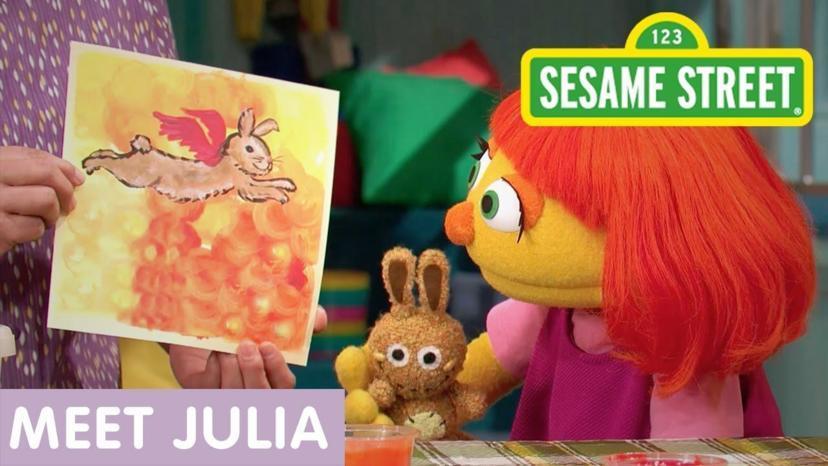Meet the Team Behind Sesame's Street's Special Needs Character: Julia

Sesame Street is a wildly popular educational TV series that began to shape our culture on November 10th, 1969. Since then, it has been a long-time favorite of both children and adults. The show combines puppetry, dialogue, and comedy to help educate children on topics such as the alphabet, numbers, colors, and shapes. Sesame Street’s main characters include Big Bird, Elmo, Bert, Ernie, Grover and Oscar the Grouch, among others.
The powerful effect Sesame Street has on children
For years, the show’s creators have been introducing interesting content on the show, including life lessons, birthdays, injuries, families with loved ones in the military, marriage, grief, and more. Yet, one of the greatest innovations made in the long history of story-telling took shape in the late 1990s. Leslie Kimmelman, editor of Sesame Magazine at the time, began to notice that some of her colleagues who brought their children to work had autism. Knowing how the characters on Sesame Street had an immense impact on children. “There was a small group of us, parents with kids on the spectrum, who knew how powerful the show’s effect was on our children. Leslie wanted to raise awareness on the subject of autism while allowing children with autism someone relatable to themselves.
Meet Julia.
An opportunity to increase awareness and understanding
Julia is a newly introduced character on Sesame Street, who made her debut on April 10th, 2017 in an episode titled “Meet Julia”. She is four years old, has bright orange hair, wears a pink dress, and walks around carrying a toy rabbit called Fluffster. What sets her apart from all the other characters has nothing to do with her image or attire – Julia has autism. Sherrie Westin, executive vice president of global social impact and philanthropy at Sesame Workshop, explained that she and her team aimed to address the subject of autism because of the vast growth of children diagnosed with autism spectrum disorder within recent years. “It was an opportunity to help explain autism and to help increase awareness and understanding,” she said. After debating that autism affects more girls than it does boys, Sesame Street decided that the character would be a girl and Kimmelman proposed naming the character Julia, after her oldest daughter.
Before officially launching Julia, Sesame Street released several video clips of the episode, all of which had Julia interacting with some of the show’s characters. In one particular clip, when Big Bird goes to say hi to Julia, she carries on painting instead of saying hi back. This leaves Big Bird confused, thinking that Julia doesn't like him. “We had to explain to Big Bird that Julia likes Big Bird. It’s just that Julia has autism. So sometimes it takes her a little longer to interact." In another clip, Elmo sees that Julia is playing with her toy rabbit on her own and tells her they can play side by side. There’s lots of ways to play.”
When the episode launched, it ran along explaining how Julia does things a little differently, such as playing tag while jumping. “I’ve never seen tag played like that,” said Big Bird. Alan, the owner of Hooper’s store on Sesame Street, explained to Big Bird that although it may seem confusing, it was just Julia’s unique way of playing the game.
The introduction of Julia’s character was a nationwide success. “My reaction was total excitement, the excitement of seeing a new life come into the world. For all the little kids who have autism, it’s validating to see characters like themselves on television, instead of feeling invisible,” said Rose Jochum, Director of Internal Initiatives at Autism Society of America. She recalled one scene in particular, when Alan helped calm Julia from a passing police siren, to be extremely powerful. “Watching the two of them interact. That was special to see,” said Jochum.
The woman behind Julia’s character has first-hand experience with autism
Julia’s character on Sesame Street is portrayed by Stacey Gordon, who has a 13-year-old son with autism. The ‘Meet Julia’ episode is something that I wish my son’s friends had been able to see when they were small. I remember him having meltdowns and his classmates not understanding how to react,” said Gordon. The most impressive and powerful result of Sesame Street’s invention of a character with autism actually came from the reaction of children with autism, who saw a reflection of themselves. The show’s team received letters and emails from children all over the United States and from across the globe. One email addressed to Julia read – “I am a grown-up. But I am like you. I am scared of noises. I don’t like my hair to bother me. What I say doesn’t always make sense to other people.” The email goes on to read – “I hope you like ‘Sesame Street’. I hope you meet lots of kind, good people there. I will watch you on TV. And maybe I will get to meet you someday...but only if that’s okay with you.”
Honoring Autism Awareness Month
Today, 1 in 68 children are on the autism spectrum and 1 in 59 boys. Autism is characterized by communication difficulties, social-interaction challenges, and engagement in repetitive behavior. Sesame Street continues to build on Julia’s character and is dedicated to increase the public’s awareness of autism, all the while helping children with autism and their families. On April 9th, an episode named “Shape Hunt” aired, in honor of Autism Awareness Month. In the episode, Julia and her friends Cookie Monster, Abby Cadabby, and Grover, are all playing a game that involves spotting shapes. Each team receives a list of shapes that they need to find around their street and it is Julia’s unique perception of things that helps her find shapes in places that no one else seems to notice.
See the Amazing in All Children
Sesame Workshop’s introduction of Julia’s character is a part of a nationwide initiative - Sesame Street and Autism: See Amazing in All Children, which launched in 2015. It was developed by individuals with autism, parents of children with autism, as well as individuals who serve among the autism community. The aim is to offer children with autism and their families unique approaches to managing day-to-day routines, overcoming challenges, and developing supportive relationships with family members, friends, and the outside community. A recent survey revealed that in the United States, more than 50% of adults and 77% of parents of young children with autism have heard of Julia on Sesame Street. To date, Sesame Street and Autism: Seeing Amazing in All Children has gathered over 2.5 million-page views from over 600,000 users and has sold hundreds of thousands of both print and digital copies of the storybook - ‘We’re Amazing 1,2,3!’, centered around friendship and autism.
“Seeing the difference that Julia has made since her debut on Sesame Street has been heartwarming, and we’re thrilled to expand our commitment to the autism community with new resources that can make a real difference in the lives of children and families,” said Westin.
References
https://en.wikipedia.org/wiki/Sesame_Street
https://www.theguardian.com/tv-and-radio/2017/mar/20/sesame-street-autism-muppet-julia
https://autism.sesamestreet.org/about-this-initiative/
https://www.smithsonianmag.com/innovation/team-sesame-street-created-character-autism-180967218/
Photo credit: Photo: Sesame Street (YouTube)















